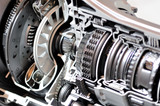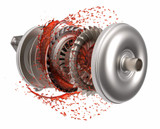Shifting Into Overdrive—Part II
When we began building the Hot Rod Hauler, our updated ’73 Ford F-350, we had a number of objectives. One of the most ambitious was to increase fuel economy while maintaining towing capacity. The first modification toward that goal was the installation of an E40D overdrive automatic transmission from Gearstar Performance Transmissions.
As we showed last month, replacing the C6 with an E40D was not without challenges. There were some crossmember modifications required, the gas tank had to be slid back in its mounts, and the front end still required some “massaging” with a rubber mallet. However the biggest challenge was the shift linkage. It could have been done with a cable but we elected to take advantage of our friend and master machinist, Tim Smith, and build a mechanical linkage with a bellcrank.
With the mechanical part of the installation done, it was time to turn our attention to the computer and wiring harness that makes our high-tech trans work. From a functional standpoint the E40D has some unique features. As you would expect, Park, Reverse, and Neutral are standard shifter positions, but unlike many other four-speed overdrive automatics there are only three other shifter positions—D, which allows the transmission to shift through all four gears, D2 which locks the transmission in Second gear only (the vehicle stars in second and stays there), and D1, which locks the transmission in First and keeps it there. What’s missing is a Third gear position, but while it may not be on the gearshift indicator, it is available at the push of a button. Activating the “cancel switch” prevents the transmission from shifting into Fourth (however the converter will still lock).
In stock from the E40D is controlled by a system referred to as the EEC-IV, it’s a processor that controls both he engine and transmission. What we needed was a stand-alone controller to operate just the transmission and through Gearstar we found just what we needed; the Compushift II from HGM Automotive Electronics, a specialty equipment manufacturer that designs and supplies leading eddge electronic systems for automotive aftermarket use. Compushift II operates automatic shifting, paddle shifting, and torque converter clutch lockup for a wide variety of transmissions, including the E40D.
Installing the compute rand wiring harness is simple enough, however we urge you to go against the normal tendency to disregard the instruction manual and dive in. Despite the fact that al the wires are clearly labeled, all the plus are dedicated and will only fit in the proper place. Improper installation can not only keep the transmission from operating properly, it can damage the control unit. So do yourself and the tech guys at HGM a favor and read the manual before you begin installation.
While we are on the subject of installing the HGM controller, we should touch on what can go wrong and, surprisingly, the most common problem is to avoid—poor grounds. After everything in your truck is painted, plated, and powdercoated, it can be tough to find a good spot to ground electrical components, but a good ground is absolutely essential to the proper operation of the HGM system (as well as every other electrical device). That’s why HGM recommends grounding their system directly to the block (but the connection point still needs to be clean, bare metal).
We began our installation by running all the wires to their various locations. The big trick here is to route them out of harm’s way, avoiding things like the exhaust system and sharp edges that can damage wire. With the harness installed, the next chore was to find a place to mount the control unit inside the cab.
The next step was attaching the throttle position sensor to the carburetor. For carbureted engines HGM offers their AccuLink kit to mount a TPS on virtually any carburetor. For those engines that are fuel injected, the existing TPS can be used to supply the transmission computer the necessary signal.
With the installation complete it was time to do what we feared most, the electronic wizardy that’s normally the domain of 12-year-olds—programming. Fortunately for most of us, a PC, laptop, or other type of computer isn’t needed as the system is delivered with factory set programming; however a PC can be connected via the USB port for system software updates and tuning if desired. Dual CAN buses can connect to existing engine management or body control computers. A MAP sensor can be connected for turbocharged applications if needed.
For the system to operate, the TPS has to be calibrated. Start the engine and allow it to warm up enough so it’s no longer on fast idle or choke. Then turn the engine off.
With the vehicle in park and engine off, turn on the ignition switch to provide power to your Compushift II. Wait five seconds.
Enter setup mode on the display and press the right arrow (next screen), the TPS Calibration Setup screen is visible.
Press the entire button and you’ll have five second to completely depress and release the throttle pedal. This one stroke of the be done in a slow, even motion before the five seconds elapse.
Once you’ve stroke the throttle, wait five more seconds, and then observe the status LED on the Compushift II Controller—it should be green and solidly lit (not blinking).
Depress the throttle pedal completely and hold it in for five seconds. The LED should still be green and solidly lit.
With the TPS calibrated, all that was left was to take the truck for a drive. Under light throttle the Gearstar E40D shifted quickly and smoothly, but when we stuck our foot in it, the shifts were later and much firmer. We found the gear ratios are ideally suited to our needs but the biggest difference was the overdrive top gear and the lockup converter; at highway speeds the reduced rpm has made a noticeable reduction of engine noise in the can and throttle response without the slippage of a standard converter is noticeably improved. Although we haven’t had the opportunity to compare mileage, we’re hopeful and will report soon. Stick around, there’s more Hot Rod Hauler to come.
 |
Gearstar offers a variety of transmissions to suit any application from street race and everything in between. Our trans was a Level III, built to withstand the rigors of towing. |
| Modern electronic transmissions are “brain dead” without a computer, we used a Compushift from HGM to control ours. |  |
 |
The available Compushift display is used to program the TPS and other functions. It can also provide a host of information about the transmission as you are driving. |
| The control box has dedicated plus for the engine and input power and ground on one end. |  |
 |
On the other end are the plugs for the transmission harness and the display unit. |
| So air could circulate around the control unit we mounted it to the inside of the firewall on four plastic spacers. |  |
 |
To mount the control unit securely threaded inserts were put into the firewall. |
| Space is at a premium under the dash, so the control unit was mounted to the left of the steering column. Rubber grommets were used to protect the wiring passing through the firewall. |  |
 |
HGM recommends that the control unit be on a dedicated electrical circuit. As we would be adding more electronics later, such s a Dakota Digital dash and a FAST fuel injection computer, we elected to install additional supply points with this Painless fuse center. |
| This is the optional Fourth gear lockout button; it connects to the HGM harness. Not necessary in all applications, we installed it to keep the transmission from repeated up and down shifting when pulling long grades while heavily loaded. |  |
 |
This is the AccuLink TPS control kit, we installed it on our Edelbrock carburetor. When we switch to fuel injection we’ll wire that system’s TPS to the transmission control. |



